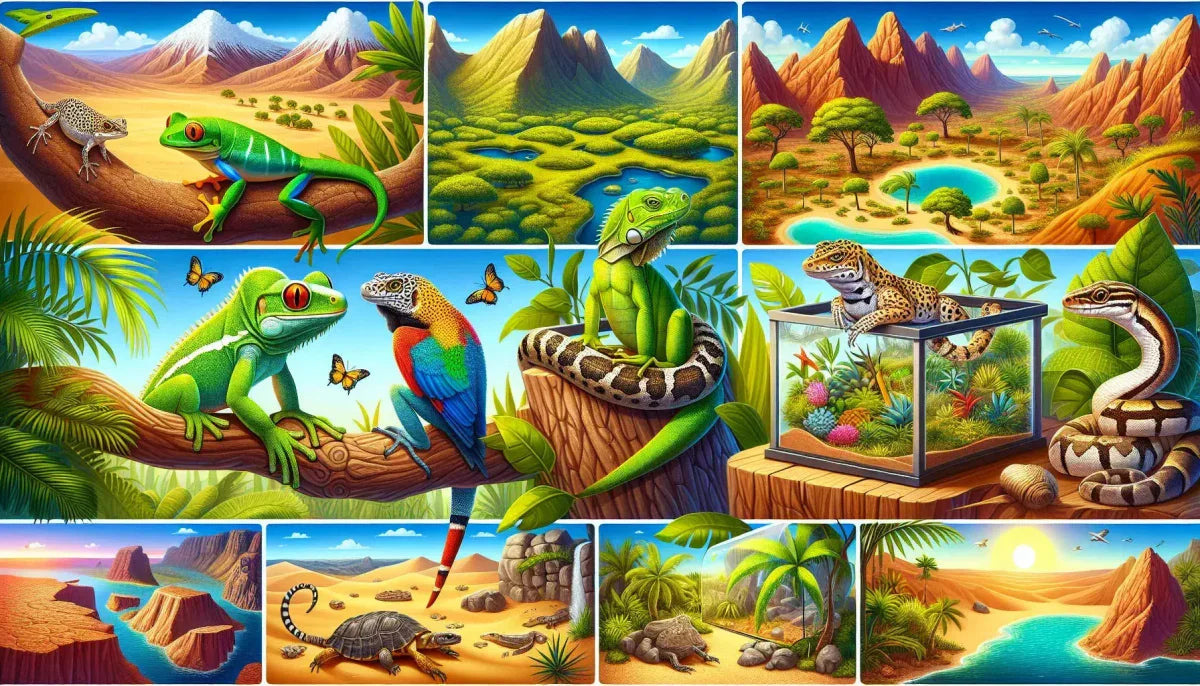Welcome to the fascinating world of reptile habitats!

Whether you're a seasoned reptile enthusiast or a newcomer to the reptile-keeping community, understanding the intricacies of creating the perfect habitat is crucial for the well-being of your scaly friends. In this comprehensive guide, we will delve into the essential elements of reptile habitats, including temperature regulation, lighting, substrate, and enclosure size. From the arid deserts to the lush rainforests, each reptile species has unique habitat requirements, and we'll explore how to replicate these environments in captivity. Additionally, we'll discuss the importance of environmental enrichment and how to create a stimulating and enriching habitat for your reptile companions. By the end of this guide, you'll be equipped with the knowledge and practical tips to create a safe, comfortable, and enriching habitat that meets the specific needs of your reptilian pets.
Reptile Habitats
Reptiles are a diverse group of animals that inhabit various types of environments. Understanding the different types of reptile habitats is crucial for their proper care and conservation. In this section, we will explore three main types of reptile habitats: Terrestrial Habitats, Aquatic Habitats, and Arboreal Habitats.
Terrestrial Habitats
- Terrestrial habitats are land-based environments where reptiles such as snakes, lizards, and tortoises thrive.
- These habitats can range from deserts and grasslands to forests and scrublands.
- Reptiles adapted to terrestrial habitats often have specialized features such as heat-resistant scales, camouflage, and efficient burrowing abilities.
- Providing a suitable terrestrial habitat in captivity involves mimicking natural elements like temperature gradients, hiding spots, and substrate for burrowing species.
Aquatic Habitats
- Aquatic habitats encompass freshwater and marine environments where reptiles like turtles, crocodiles, and certain snakes are found.
- These habitats can include ponds, rivers, lakes, and coastal areas.
- Reptiles adapted to aquatic habitats have evolved streamlined bodies, webbed feet, and the ability to hold their breath for extended periods.
- Creating an ideal aquatic habitat for captive reptiles involves maintaining water quality, offering basking areas, and providing appropriate aquatic vegetation or structures for enrichment.
Arboreal Habitats
- Arboreal habitats refer to tree-dwelling environments inhabited by reptiles such as certain snakes, geckos, and chameleons.
- These habitats are characterized by vertical space, foliage, and specialized adaptations for climbing and camouflage.
- Reptiles adapted to arboreal habitats often possess prehensile tails, grasping feet, and color-changing abilities.
- Designing a suitable arboreal habitat in captivity requires vertical space, climbing structures, foliage for hiding, and proper lighting to support natural behaviors.
Understanding the specific requirements of each type of reptile habitat is essential for creating enriching and sustainable environments for captive reptiles. By replicating natural habitats to the best of our abilities, we can ensure the well-being and longevity of these fascinating creatures.
Creating an Ideal Reptile Habitat
When creating an ideal habitat for your reptile, there are several factors to consider. These include temperature, lighting, humidity, substrate, shelter, decor, plants, and environmental enrichment. Each of these factors plays a crucial role in ensuring that your reptile thrives in its environment.
Temperature, Lighting, and Humidity
Reptiles are ectothermic, meaning they rely on external sources of heat to regulate their body temperature. It's essential to provide a temperature gradient within the habitat, allowing the reptile to move between warmer and cooler areas as needed. Additionally, appropriate lighting, including UVB exposure, is vital for reptiles to synthesize vitamin D3 and maintain overall health. Humidity levels should also mimic the reptile's natural environment to support proper shedding and respiratory function.
Substrate, Shelter, and Decor
Choosing the right substrate is crucial for maintaining hygiene and providing a comfortable surface for your reptile. The type of substrate will vary depending on the species, with options such as reptile carpet, coconut fiber, or paper towels. Providing shelters and decor, such as caves, branches, and hides, gives the reptile opportunities to hide, climb, and explore, reducing stress and promoting natural behaviors.
Plants and Environmental Enrichment
Incorporating live or artificial plants into the habitat not only enhances its visual appeal but also provides hiding spots and contributes to the overall environmental enrichment. Environmental enrichment is essential for keeping reptiles mentally stimulated and preventing boredom. This can include introducing novel items, creating foraging opportunities, and varying the habitat's layout periodically.
By carefully considering these factors and providing an environment that meets your reptile's specific needs, you can create an ideal habitat that promotes their well-being and allows them to exhibit natural behaviors.
Mistakes to Avoid in Reptile Habitat Setup
When setting up a habitat for your reptile, it's crucial to avoid common mistakes that can impact the well-being of your pet. In this section, we will explore the common errors in habitat design and the impact of inadequate habitat on reptile health.
Common Errors in Habitat Design
One of the most common mistakes in reptile habitat design is inadequate space. Many reptile owners underestimate the space requirements of their pets, leading to cramped and stressful living conditions. It's essential to research the specific spatial needs of your reptile species and provide ample room for movement and natural behaviors.
Another frequent error is improper temperature and humidity levels. Reptiles are ectothermic, meaning they rely on external sources of heat to regulate their body temperature. Failure to provide the correct temperature gradients and humidity levels can result in health issues such as respiratory infections and poor digestion.
Inadequate substrate selection is also a prevalent mistake. The substrate plays a crucial role in maintaining proper hygiene and providing a comfortable surface for your reptile. Using the wrong type of substrate or failing to clean it regularly can lead to skin problems and bacterial infections.
Impact of Inadequate Habitat on Reptile Health
The consequences of an inadequate habitat can be severe for reptiles. Chronic stress from cramped living spaces or improper environmental conditions can weaken the immune system, making the reptile more susceptible to diseases. Inadequate temperature and humidity regulation can lead to dehydration, respiratory issues, and difficulty shedding, all of which can significantly impact the reptile's health and well-being.
Furthermore, inappropriate substrate choices or poor maintenance can expose the reptile to harmful bacteria and parasites, increasing the risk of infections and gastrointestinal problems.
Avoiding these common mistakes in reptile habitat setup is essential for promoting the health and happiness of your pet. By providing adequate space, maintaining proper environmental conditions, and selecting suitable substrates, you can create a habitat that supports your reptile's physical and psychological well-being.
Conclusion
Creating the perfect habitat for your reptile is essential for their well-being and happiness. Whether you have a turtle, lizard, frog, or snake, providing a suitable environment is crucial. The webpage for Zilla Micro Reptile and Amphibian Habitats Arboreal on Talis US offers a wide range of high-quality products and supplies tailored to meet the specific needs of reptile and amphibian enthusiasts. From terrariums to food options, this webpage has everything you need to create the ideal habitat for your pet. For a comprehensive selection of habitats, ornaments, and housing accessories, visit. Zilla Micro Reptile and Amphibian Habitats Arboreal And give your reptile the home they deserve.





